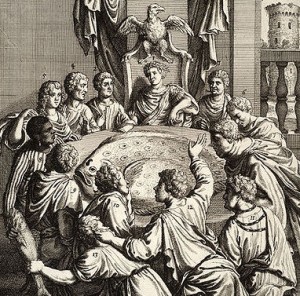 There’s plenty of buzz in the blogosphere about an under-the-radar meeting that took place last week between top newspaper executives to discuss issues of common concern, including the possibility of charging for online access to news. Speculation centers upon whether the participants, which included McClatchy’s Gary Pruitt, Dallas Morning News Publisher Jim Moroney, Lee Enterprises’ Mary Junck and E.W. Scripps Mark Contreras, allowed the discussion to stray into the terms under which their organizations could erect pay walls in front of content.
There’s plenty of buzz in the blogosphere about an under-the-radar meeting that took place last week between top newspaper executives to discuss issues of common concern, including the possibility of charging for online access to news. Speculation centers upon whether the participants, which included McClatchy’s Gary Pruitt, Dallas Morning News Publisher Jim Moroney, Lee Enterprises’ Mary Junck and E.W. Scripps Mark Contreras, allowed the discussion to stray into the terms under which their organizations could erect pay walls in front of content.
The Newspaper Association of America (NAA) says price was never discussed during the meeting, and that’s good, since federal antitrust laws are pretty specific about such things. There’s no law against competitors discussing common issues, but setting prices is a no-no.
Conventional wisdom says that newspaper price-fixing would be dead on arrival, but some people argue that the Supreme Court’s 2007 decision in Bell Atlantic Corp. v. Twombly set a precedent under which an aggregator representing multiple properties could get away with charging fees for access. Slate’s Jack Shafer weighs the possibilities and concludes that collusion would be an exceedingly risky move under an administration that has promised to be tough on businesses.
Pat Thornton sees the devil in the details. People aren’t going to pay for to read the police blotter and it’s going to be even tougher to sell them on having to buy services that used to be free, he says. “You can’t charge for something that has been free for years without drastically improving it,” argues Thornton. Given that news organizations have been cutting resources left and right, it’s pretty difficult to argue that the product is getting any better.
There actually is precedent for Web publishers charging for services that were once free. In the heady days of the dot-com bubble, nearly everything was gratis on the web. After market realities forced businesses to create sustainable models, photo- and video-sharing sites that were once free began to charge membership fees. Some businesses and specialty publishers also began linking Web access to paid print subscriptions, a model that persists to this day at publications like Advertising Age.
Perception of Value
Thornton has got it right that perceived value is the crux of the issue. Consumers understand that technology isn’t free and accept that publishers must charge for niceties like unlimited storage. They also appreciate that unique, unduplicated services are worth a subscription fee if the information is vital to their job or avocation.
 We personally like the model of Geocaching.com, the website that serves the addictions of millions of avid gamers who search for treasures stashed in outdoor locations around the world. A basic subscription to the site is free, but services that significantly enhance the pleasure of playing the game demand a $30 annual subscription.
We personally like the model of Geocaching.com, the website that serves the addictions of millions of avid gamers who search for treasures stashed in outdoor locations around the world. A basic subscription to the site is free, but services that significantly enhance the pleasure of playing the game demand a $30 annual subscription.
Geocaching.com enjoys the advantage of being a near-monopoly in its market. There’s nothing wrong with that, though. The publisher has succeeded in providing a comprehensive database of information that its constituents can’t get anywhere else.
We continue to believe it’s highly unlikely that publishers will succeed in establishing an industry-wide paid content model. Anyone who fails to join the consortium could potentially disrupt the whole deal, and too many alternative sources of free information already exist. CNN, for example, will never join such a group. Instead, it will benefit from the vast traffic that will stream to its website when the pay walls go up.
Individual publishers may succeed in charging for content, but they’ll do it with content that serves a vital interest or need in their communities. There are plenty of possibilities, but they will be exploited by innovative people at the local level, not mandated from the top by a few executives who are motivated more by self-preservation than serving the interests of their audience.
Comments
This entry was posted on Monday, June 1st, 2009 at 2:57 pm and is filed under Facebook, Fake News. You can follow any responses to this entry through the RSS 2.0 feed. Both comments and pings are currently closed.



I truly find this fascinating. I have been reading for months and now watching newspaper after newspaper go out of business or cutback. I understand the debt structure. I really do. And for those of you in that position, God Bless you and good luck.
I still believe most of you do not understand the Internet and moreover you do not understand the “new” business, sales and marketing models. I can only speak from my experience as the publisher of the largest Catholic media company, our ad sales are up over 40% this year. We are now about 1 month out from launching 10 Local editions in 10 of the largest cities in the U.S., all Internet based. The aggregate total of local catholic ads are over 1 billion dollars per year to our paper publications. Yes, that is 1 billion U.S. dollars. We are now converting at an average of 20% + to Internet based at a extremely low marketing dollar output. However, we now have the tools to offer to our online advertisers including (our version of adwords). This is but one of the features we now control for our new distribution model.
I again can not understand why you just don’t get it. This is ALL about the USERS – not the publishers. This is truly a tectonic shift and you must have be the best to ride this wave.
I would welcome any feedback here or to my email – mlg@catholic.org…..
Part of the reason that Geocaching is successful is that it sued or threatened lawsuits against sites that publish geocache data, claiming it as proprietary in various complicated ways.
In other ways, they acted like newspapers want to do – threatening other places that are providing information they think is theirs.
[…] Did Publishers Collude? Does it Matter? (newspaperdeathwatch.com) […]